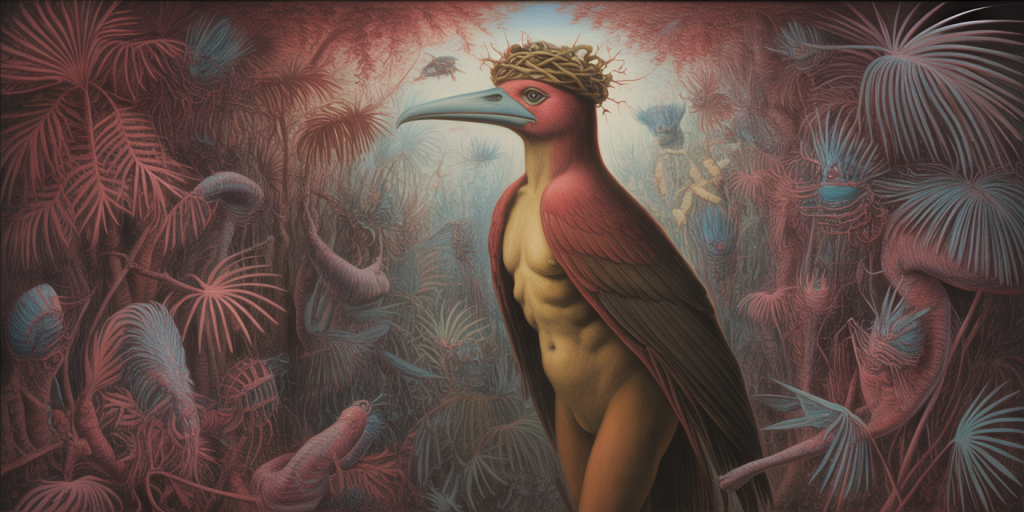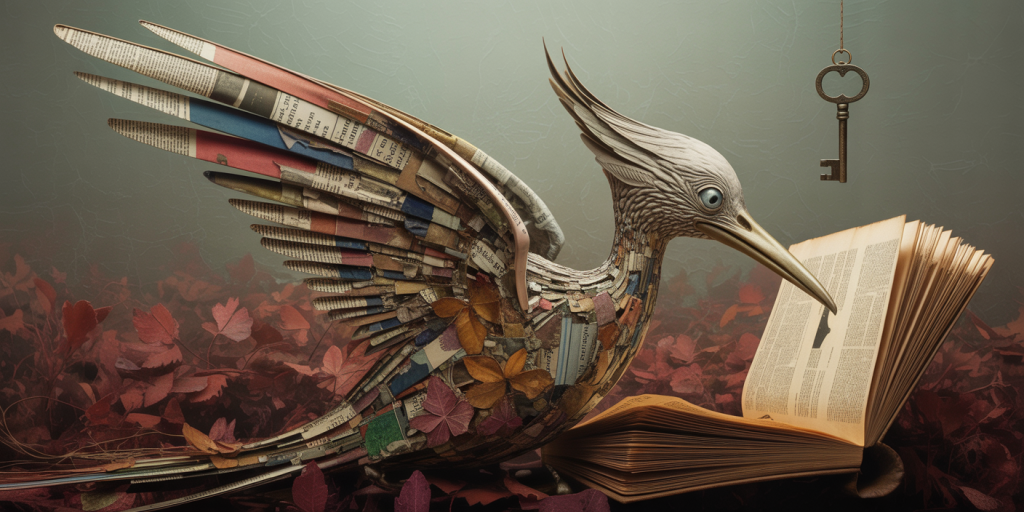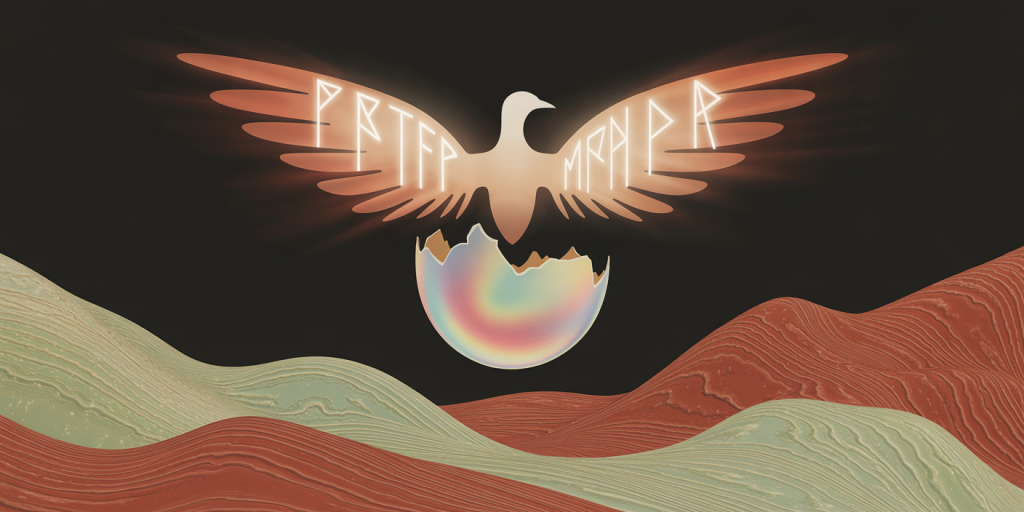Max Ernst and the Bird-Alchemists of the Subconscious
There are wings that beat not in the sky but in the hollows of the mind. In Max Ernst’s paintings, birds do not merely fly—they remember. They crawl out of fossilized dreams, burst from symbolic eggs, perch in the crevices of forgotten mythologies. These are no common sparrows or pigeons; they are alchemical creatures, forged in the crucible of the subconscious. With feathers dipped in archetype and beaks sharpened by surreal logic, Ernst’s birds whisper secrets between sleep and revelation.
His canvases are not windows to landscapes but to laboratories of metamorphosis. The bird becomes avatar, witness, intruder, and oracle. And as we stand before his riotous jungles, scarlet skies, and pale, bleeding moons, we are made participants in an initiatory rite: a transformation not of matter, but of meaning. In Ernst’s world, to see the bird is to glimpse the self undone.
Table of Contents
- Feathers as Symbols of Flight and Fragment
- Loplop: The Sovereign of the Subconscious
- Beaks That Pierce the Mirror
- Jungles Grown from Forgotten Thought
- Eggshells of Mythical Rebirth
- The Architecture of Bird Bones
- Alchemy Painted in Crimson and Ash
- Shadows Cast by Wings on Fire
- The Theater of Inner Plague
- Collage as Cognitive Excavation
- When Color Dreams in Feathers
- Landscapes Ruled by Ornithological Memory
- The Beating Heart of Frottage
- Dada’s Bird With a Mask
- Birds as Anatomists of Anxiety
- Beasts of Feathers and Flesh
- Uncaged Light and the Instinct to Ascend
- Eyes in the Shape of Wings
- The Fossilized Flight of Desire
- Echoes of Wingbeat in the Silence of Canvas
Feathers as Symbols of Flight and Fragment
Ernst’s feathers are more than natural forms; they are codes. Each plume seems torn from an angel who never believed in purity. Their softness contains a fractured elegance, each barb an echo of departure. These feathers do not flutter. They haunt.
Loplop: The Sovereign of the Subconscious
Loplop, Ernst’s bird alter ego, is no mere invention—he is the crowned prince of the inner abyss. With a human torso and avian mask, he functions as intermediary between visible and veiled. Loplop speaks in symbols, walks through dreams, and commands the surreal stage like a mythic conductor.

Beaks That Pierce the Mirror
The beak, in Ernst’s visual lexicon, is a dagger. It punctures illusions. Whether pecking at cosmic yolks or slicing through surface reality, it functions as a dissecting tool of identity. The beak is the instrument of both violence and vision.
Jungles Grown from Forgotten Thought
His landscapes teem with foliage that seems to have sprouted from a child’s nightmare or an alchemist’s table. Trees twist like arteries, roots drink from ink, and vines seem to murmur forgotten dialects. These jungles are not botanical—they are mental.
Eggshells of Mythical Rebirth
The egg appears not just as symbol of origin, but of rupture. Its cracking is not quiet but seismic. In Ernst’s world, rebirth is not serene; it is clawed into being. The yolk becomes golden chaos, and the shell a record of psychic escape.
The Architecture of Bird-Bones
Ernst sometimes renders skeletal bird-forms like cathedrals. Ribs arch like vaults. Claws curl like gothic filigree. These are not carcasses—they are monuments. The body becomes a chapel of silent screaming, ossified in surreal reverence.
Alchemy Painted in Crimson and Ash
His palette glows with transformation. Crimson like living fire, ash grey like memory turned to dust. These are not colors meant to please. They are emotional reagents. Each hue reacts with the soul, and through this alchemy, the viewer is transmuted.
Shadows Cast by Wings on Fire
There is often light in Ernst, but it is not soft. It strikes like revelation. Shadows stretch under flaming wings, creating chiaroscuro moods where the subconscious becomes theatrical. The bird does not hide in light; it becomes the silhouette that defines it.
The Theater of Inner Plague
Figures in Ernst’s compositions sometimes crowd together in grotesque tableaux, birds intermingled with hybrid monsters. These scenes feel like psychic rituals. There is no narrative, only contagion. These images speak of interior infections—fevered thoughts, compulsions, obsessive rebirths.
Collage as Cognitive Excavation
Ernst’s collage technique slices through reality like a scalpel. Cut fragments of Victorian etchings, medical diagrams, and flora fuse into new beings. This is no decorative craft—it is mental archaeology. The mind is unlayered, rearranged, sutured.

When Color Dreams in Feathers
Colors in Ernst do not fill space—they mutate it. Rust, emerald, obsidian, ochre—his tones feel excavated. A feather here is not blue—it is sleep-colored. The pigments pulse with symbolic heat, as though applied by dream rather than hand.
Landscapes Ruled by Ornithological Memory
Every terrain in Ernst’s paintings feels governed by a bird’s memory. Mountains seem to tilt for wings. Rivers curve as if mimicking flight paths. There is a vertigo in his topographies—as if the horizon forgot how to hold still.
The Beating Heart of Frottage
Frottage, Ernst’s signature technique, begins with rubbing paper over textured surfaces. But what emerges is not mere texture—it is the heartbeat of the unconscious. Patterns emerge like fossils. Frottage becomes the whisper of forgotten touch.
Dada’s Bird With a Mask
Born from Dada’s chaos, Ernst’s birds still carry its laugh—though now darker. The absurdity of war, the rupture of logic, the collapse of reason—all perch within the feathers. The mask worn by the bird becomes our own.
Birds as Anatomists of Anxiety
There is always something clinical in Ernst’s birds—as if they are dissecting the psyche. They hold scalpels made of feather. They gaze into the viewer as if diagnosing. Their eyes do not blink. They analyze the dream.
Beasts of Feathers and Flesh
Hybrids abound. Beasts made of beak and muscle, of root and talon. They are not monsters but metaphors. Each one is a rejected emotion given wings. These creatures live where trauma becomes form.
Uncaged Light and the Instinct to Ascend
The bird, for all its darkness in Ernst’s world, remains a symbol of ascent. Its presence is a reminder of the sky, even in the heaviest psychic gloom. The act of flight is retained—not literal, but metaphysical.
Eyes in the Shape of Wings
Eyes are often displaced in Ernst’s works—hidden in plumage, floating in air. Sometimes, the eyes become wings themselves. Vision is no longer passive. It is action. To look is to fly. To observe is to alter.
The Fossilized Flight of Desire
Desire in Ernst’s world is not erotic in a traditional sense. It is archaic, primal, sacred. His birds remember ancient cravings—freedom, merging, transformation. Desire is fossilized in their very bones, pressed into the pigments like prehistoric longing.

Echoes of Wingbeat in the Silence of Canvas
What remains after Ernst’s birds leave the frame is silence. Not emptiness—but aftermath. The echo of wings haunts the canvas. We are left not with answers, but with talons on the edge of our memory. His birds do not sing. They remain.
FAQ
Who was Max Ernst?
Max Ernst (1891–1976) was a German painter, sculptor, and poet who played a pivotal role in the Dada and Surrealist movements. His work explored the unconscious through experimental techniques like frottage, collage, and automatism.
What is Loplop?
Loplop is a recurring bird-like figure in Ernst’s work, often seen as his alter ego or a symbolic narrator. It blends avian, human, and mythic qualities, serving as a conduit for Ernst’s inner world.
What techniques did Ernst use?
Ernst invented or developed techniques such as frottage (rubbing), grattage (scraping), decalcomania (pressing paint), and extensive collage. These allowed him to bypass rational control and access the subconscious.
Why are birds so important in his work?
Birds in Ernst’s oeuvre symbolize transformation, freedom, and the interface between instinct and intellect. They serve as oracles, invaders, and guides within his surreal mythologies.
Is Ernst’s work political or psychological?
Both. While rooted in the subconscious and surreal logic, his works reflect on war, trauma, repression, and the rupture of modern life. His birds often carry silent commentary on violence, exile, and recovery.
Final Reflections: Wings Dipped in Thought
Max Ernst painted not the bird as seen, but the bird as known by shadow and silence. His creatures do not sing—they remember. Each feather a page of symbolic scripture, each beak a whisper from beneath the floorboards of the mind.
In their flight, we rise. Not upward, but inward. Not toward sky, but into the mythic self. Ernst’s bird-alchemists stir the paint of dreaming, melt logic into wing, and carve a hole in the world through which meaning slips in.
The canvas, when he finishes, no longer hangs. It hovers. It watches. And we, once mere observers, become the ones who molt.
